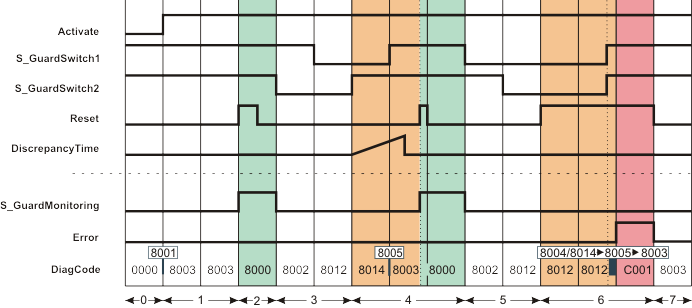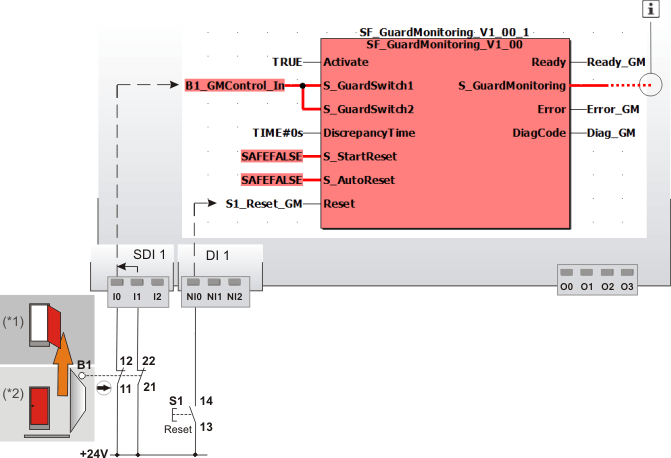The following description is valid for the function block SF_GuardMonitoring_V1_0z, Version 1.0z (where z = 0 to 9).
Short description
|
The safety-related SF_GuardMonitoring function block monitors a guard (e.g., door) with two-stage interlocking according to the EN 1088 standard. S_StartReset can be used to specify a start-up inhibit and S_AutoReset can be used to specify a restart inhibit. |
|
Function block inputs
Click the corresponding hyperlinks to obtain detailed information on the items below.
|
Name |
Short description |
Value |
|
State-controlled input for activating the function block. Data type: BOOL Initial value: FALSE |
|
|
|
State-controlled inputs for the connected position switches of the door. For the S_GuardMonitoring output to switch to SAFETRUE, both inputs S_GuardSwitch1 and S_GuardSwitch2 must switch to SAFETRUE within the time set at DiscrepancyTime. Data type: SAFEBOOL Initial value: SAFEFALSE NOTE: If only one signal reports the status of the door (one position switch only), this must be connected in parallel to both inputs S_GuardSwitch1 and S_GuardSwitch2. Where this is the case, a time of 0 seconds must be set at DiscrepancyTime. |
|
|
|
Input for specifying the maximum permissible discrepancy time for the closing operation of the safety equipment. Data type: TIME Initial value: #0ms If S_GuardSwitch1 or S_GuardSwitch2 switches to SAFETRUE, the respective other input (S_GuardSwitch1 or S_GuardSwitch2) must also switch to SAFETRUE within the time set at DiscrepancyTime for the switching operation to be considered as valid. If not both inputs have switched to SAFETRUE after the time set at DiscrepancyTime has elapsed, an error message is generated (Error = TRUE) and the S_GuardMonitoring output remains in the defined safe state SAFEFALSE. |
Enter a time value according to your risk analysis. Refer to the first hazard message below this table. |
|
|
State-controlled input for specifying the start-up inhibit after the Safety Logic Controller has been started up or the function block has been activated. Data type: SAFEBOOL Initial value: SAFEFALSE An active start-up inhibit must be removed manually by a positive signal edge at the Reset input. A deactivated start-up inhibit causes the S_GuardMonitoring output to switch to SAFETRUE automatically when the function block is activated and the safety-related function is not requested. Refer to the second hazard message below this table. |
|
|
|
State-controlled input for specifying the restart inhibit after the previously opened safety equipment has been closed (in other words, after the SAFETRUE signal has returned at inputs S_GuardSwitch1 and S_GuardSwitch2). Data type: SAFEBOOL Initial value: SAFEFALSE An active restart inhibit must be removed manually by a positive signal edge at the Reset input. A deactivated restart inhibit causes the S_GuardMonitoring output to switch to SAFETRUE automatically when the function block is activated and the safety-related function is no longer requested. Refer to the second hazard message below this table. |
|
|
|
Edge-triggered input for the reset signal:
Refer to the third hazard message below this table. Data type: BOOL Initial value: FALSE NOTE: Resetting does not occur with a negative (falling) edge, as specified by standard EN ISO 13849-1, but with a positive (rising) edge. |
|
WARNING
NON-CONFORMANCE TO SAFETY FUNCTION REQUIREMENTS
Verify that the time value set at DiscrepancyTime corresponds to your risk analysis.
Be sure that your risk analysis includes an evaluation for incorrectly setting the time value at the DiscrepancyTime parameter.
Validate the overall safety-related function with regard to the set DiscrepancyTime value and thoroughly test the application.
Failure to follow these instructions can result in death, serious injury, or equipment damage.
WARNING
NON-CONFORMANCE TO SAFETY FUNCTION REQUIREMENTS
Verify the impact of a deactivated start-up inhibit (S_StartReset = SAFETRUE) and/or restart inhibit (S_AutoReset = SAFETRUE) on your machine or process prior to implementation.
Observe the regulations given by relevant sector standards regarding the start-up/restart inhibit.
Verify that a suitable start-up inhibit is in place at another location or using other means.
Failure to follow these instructions can result in death, serious injury, or equipment damage.
Resetting the function block by means of a positive signal edge at the Reset input can cause the S_GuardMonitoring output to switch to SAFETRUE immediately (depending on the status of the other inputs).
WARNING
UNINTENDED START-UP
Include in your risk analysis the impact of the reset by means of a positive signal edge at the Reset input.
Make certain that appropriate procedures and measures (according to applicable sector standards) have been established to help avoid hazardous situations when resetting.
Do not enter the zone of operation when resetting.
Ensure that no other persons can access the zone of operation when resetting.
Use appropriate safety interlocks where personnel and/or equipment hazards exist.
Failure to follow these instructions can result in death, serious injury, or equipment damage.
Function block outputs
|
Name |
Short description |
Value |
|
Output for signaling "Function block activated/not activated". Data type: BOOL |
|
|
|
Output for enable signal of the function block. Data type: SAFEBOOL |
|
|
|
Output for error message. Data type: BOOL |
|
|
|
Output for diagnostic message. Data type: WORD |
Diagnostic message of the function block. The possible values are listed and described in the topic "Diagnostic codes". |
Signal sequence diagram
This diagram is based on typical monitoring of a guard with two-stage interlocking, where both position switches connected to inputs S_GuardSwitch1 and S_GuardSwitch2 switch within the time set at DiscrepancyTime.
Additional assumptions:
S_StartReset = SAFEFALSE: Start-up inhibit after the function block has been activated and the Safety Logic Controller has started up
S_AutoReset = SAFEFALSE: Restart inhibit after the previously opened safety equipment has been closed (i.e., after the SAFETRUE signals have returned at inputs S_GuardSwitch1 and S_GuardSwitch2).
NOTE:
The other signal sequence diagram can be taken into account.
NOTE:
The signal sequence diagrams in this documentation possibly omit particular diagnostic codes. For example, a diagnostic code is possibly not shown if the related function block state is a temporary transition state and only active for one cycle of the Safety Logic Controller.
Only typical input signal combinations are illustrated. Other signal combinations are possible.

|
0 |
The function block is not yet activated (Activate = FALSE). As a result, all outputs are FALSE or SAFEFALSE. |
|
1 |
Both inputs S_GuardSwitch1 and S_GuardSwitch2 are SAFETRUE. However, the S_GuardMonitoring output is still SAFEFALSE, since a start-up inhibit is specified after the Safety Logic Controller has been started up by S_StartReset = SAFEFALSE. |
|
2 |
A positive edge at the Reset input resets the start-up inhibit and the S_GuardMonitoring output switches to SAFETRUE. |
|
3 |
The safety equipment is opened. S_GuardSwitch2 and S_GuardSwitch1 switch to SAFEFALSE one after the other, and the S_GuardMonitoring output becomes SAFEFALSE. |
|
4 |
The safety equipment is closed. Measurement of the discrepancy time begins with the switch from SAFEFALSE to SAFETRUE at S_GuardSwitch2. The second input S_GuardSwitch1 also switches to SAFETRUE during the time set at DiscrepancyTime. As a restart inhibit is specified by S_AutoReset = SAFEFALSE after the safety equipment has been closed (S_GuardSwitch1 and S_GuardSwitch2 = SAFETRUE), the S_GuardMonitoring output only becomes SAFETRUE once the restart inhibit has been removed by a positive edge at the Reset input. |
|
5 |
The safety equipment is opened. S_GuardSwitch1 and S_GuardSwitch2 switch to SAFEFALSE one after the other, and the S_GuardMonitoring output becomes SAFEFALSE. |
|
6 |
The safety equipment is closed. Both inputs S_GuardSwitch1 and S_GuardSwitch2 become SAFETRUE at the same time. The function block detects the permanent TRUE signal at the Reset input as an error. Output Error becomes TRUE and output S_GuardMonitoring remains SAFEFALSE. |
|
7 |
The Reset input becomes FALSE; this causes the error message to be reset. |
Application example: Door monitoring using a mechanical position switch, start-up inhibits activated
This example describes how a mechanically activated position switch with 2 N/C contacts is evaluated using the safety-related SF_GuardMonitoring function block. Position switch B1 is connected to input terminals I0 and I1 of safety-related input device SDI 1.
The signals from position switch B1 are evaluated, based on two channels, for equivalence in the safety-related input device, which has been parameterized accordingly. The resulting signal is assigned to the global I/O variable B1_GMControl_In. This variable is connected to the inputs S_GuardSwitch1 and S_GuardSwitch2 of the safety-related SF_GuardMonitoring function block for evaluation.
B1_GMControl_In is SAFETRUE if both inputs of the safety-related input device SDI 1 are SAFETRUE at the same time (safety equipment closed) and the safety-related input device SDI 1 does not report any errors as regards exceeding the time set at DiscrepancyTime.
NOTE:
Since only one signal reports the status of the door in this example (one position switch), this is connected in parallel to both inputs S_GuardSwitch1 and S_GuardSwitch2. In this case, a value of 0 seconds is set at input DiscrepancyTime.
The function block is perpetually activated by a TRUE constant at the Activate input.
S_StartReset = SAFEFALSE specifies a start-up inhibit after the Safety Logic Controller has been started up or the function block has been activated. Furthermore, S_AutoReset = SAFEFALSE specifies a restart inhibit for the function block after the door has been closed. Both inhibits are only removed when there is a positive signal edge at the Reset input.
To this end, the S1 reset button is connected to input terminal NI0 of the standard input device DI 1. The terminal is assigned to the global I/O variable S1_Reset_GM, which in turn is connected to the function block input Reset.
NOTE:
The enable signal at the S_GuardMonitoring output of the SF_GuardMonitoring function block is connected to additional safety-related function blocks or functions and controls the application accordingly.

|
S1 |
Reset |
|
B1 |
Door switch with two positively driven N/C contacts for positive opening operation |
|
(*1) |
Door: open |
|
(*2) |
Door: closed |
|
|
See note above the illustration. |
Further Information
The other application examples and the accompanying notes can be taken into account.
Detailed information
Additional information is available in the following sections: